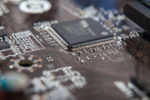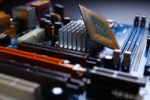Best Motherboard for Ryzen 7 5800x: Complete Reviews With Comparisons

The Ryzen 7 5800x is an elite gaming processor fully optimized for high-FPS gaming computers.
However, to accomplish such a feat with a custom build, you will need the best motherboards for Ryzen 7 5800x.
If you do an online search, it will probably return more than 200 compatible motherboards.
With this list, you won’t have to painstakingly narrow down your search.
Not only have we pinned down five excellent board options, but we have also listed the ups and downs of each.
Comparison Chart
Motherboard for Ryzen 7 5800x Reviews
1. ASRock B550 Phantom Gaming 4
The ASRock B550 Phantom Gaming 4 is a budget-oriented ATX motherboard that pairs well with the Ryzen 7 5800x.
It contains vital components a motherboard should have to run the 5800x and accommodate high-quality memory modules, storage devices, and GPUs.
Review
This motherboard features four DDR4 DIMM slots with gold-plated contact points.
These memory slots can hold up to 128GB of system RAM and provide base RAM speeds up to 3200MHz.
Overclocking the memory modules can take your rig’s memory speeds up to 4733MHz.
ALSO READ: Best Motherboard for Ryzen 9 3900x
- Expansion and Storage
This board comes with one PCIe 4.0 x16 socket and one PCIe 3.0 x16 socket. It also has two PCIe 3.0 x1 slots.
However, only the primary full-sized socket has steel reinforcement.
These expansion slots can accommodate dedicated graphics cards with support for 2-Way AMD CrossFireX and Quad-GPU configurations.
The fifth expansion slot is an M.2 socket, which ASRock installed solely for a type 2230 PCIe wireless module.
The board can lodge six SATA 6Gbps drives and two M.2 connections.
While the first M.2 slot only allows PCIe 4.0 modules, the second M.2 slot can connect SATA drives and PCIe 3.0 devices.
Keep in mind that the second M.2 slot shares its lanes with SATA3, SATA5, and SATA6.
- Rear Panel Ports
This board has a pretty basic rear I/O panel.
It doesn’t have an integrated I/O shield, but it fits in mounting brackets for a dual-band wireless module.
You will have to purchase the Wi-Fi module separately, so be sure it is the compatible kind.
Don’t worry about wired network connections, as the rear panel has an RJ45 port for its built-in Realtek RTL8111H Gigabit LAN controller.
Ports for the display and audio department are also somewhat lacking.
Nevertheless, the lone HDMI port and three audio jacks are perfectly adequate.
The only thing we found pleasing on the rear panel is the six USB 3.2 Gen1 ports and the PS/2 combo port.
There aren’t any old-school USB 2.0 ports here.
Since USB 2.0 is just enough for keyboards and mice, maybe ASRock could have lowered the cost by adding two of those instead.
Unfortunately, you won’t find any USB 3.2 Gen2 ports either.
- Internal Connectors
For additional USB ports, you can route four USB 2.0 ports and two USB 3.2 Gen1 ports through the internal headers.
Internal cooling connectors include a CPU fan header, a hybrid CPU cooling connector, and four hybrid pump or fan chassis headers.
This board provides good lighting options with two addressable RGB headers and two LED headers.
Onboard extras include a COM Port header and a TPM connector.
PROS
CONS
2. ASUS ROG Strix X570-E Gaming
The ASUS ROG Strix X570-E Gaming is a top-tier ATX motherboard that offers the perfect balance of components.
ASUS intended it for effortless overclocking, which should work seamlessly with the Ryzen 7 5800x.
Review
The main reason the Strix X570-E Gaming is better if you use it with some overclocking is its medium-range base memory speed of 2666MHz.
With some overclocking, you can push the limits up to 4400MHz.
Nevertheless, its RAM capacity is on point at 128GB if you populate all the DDR4 DIMM slots with 32GB each.
- Expansion and Storage
The Strix X570-E Gaming allows multi-graphics settings using NVIDIA 2-Way SLI, AMD 3-Way CrossFireX, or AMD 2-Way CrossFireX Technologies.
It has two full-sized metal-reinforced expansion sockets that can accommodate the latest PCIe 4.0 graphics cards.
If you plan to use a third GPU, you should choose a PCIe 3.0 device for the third x16 socket.
The latest PCIe 4.0 technology also extends to the two x1 expansion slots.
This board enables you to max out your Ryzen 7 5800x with many games and content creation software.
It won’t be having a problem with storage, as it boasts eight SATA 6Gbps ports and two M.2 slots.
While both M.2 slots also support SATA storage devices, only the primary M.2 slot can use PCIe 4.0 devices.
If you want to use the second M.2 slot for a PCIe device, it should be version 3.0.
- Rear Panel Ports
The back panel on this motherboard has a DisplayPort and an HDMI port for display output connections.
However, it is always easier to use the display ports on your graphics card.
Five premium audio jacks and an optical S/PDIF out port line the bottom of the rear panel for highly immersive audio experiences.
ASUS also equipped this motherboard with two RJ45 LAN ports and the latest Wi-Fi 6 AX200 module.
With these components, you won’t ever have to worry about network connectivity issues aside from your internet connection speeds.
While its set of eight high-speed USB 3.2 Gen2 ports is an advantage, this board can be cheaper if two of those were USB 2.0.
Going high-speed and in tune with the times could be ASUS objective, as one USB is even a Type-C.
On another note, ASUS even added a BIOS Flashback button on the rear panel for more accessible diagnostics and setups.
- Internal Connectors
If you need more USBs, internal headers allow up to seven additional ports.
However, you will have to settle for four USB 2.0 ports, two USB 3.2 Gen1, and one USB 3.2 Gen2.
The Strix X570-E Gaming makes overclocking even easier if you populate the six fan headers, two pump headers, and one thermal sensor connector.
With a bit of understanding of the extra features, you can put the TPM connector and the Clear CMOS jumper to good use.
Finally, you can change the entire appearance of your gaming rig if you use the two addressable LED headers and two RGB strip headers.
PROS
CONS
3. Gigabyte X570 Aorus Elite Wi-Fi
The Gigabyte X570 Aorus Elite Wi-Fi is an ATX board that sits somewhere in the middle of the motherboard spectrum.
It costs way cheaper than the Strix X570-E Gaming, and it provides a good mix of components for the Ryzen 7 5800x processor.
Review
Unlike the Strix X570-E Gaming, the X570 Aorus Elite has a higher base memory rate of 3200MHz.
Nevertheless, it only overclocks to the same max speed of 4400MHz, and overclocking is not as easy as with the Strix.
Like our first two options, this board has four DDR4 DIMM slots, and they can all hold a total RAM of 128GB.
- Expansion and Storage
This board’s multi-graphics support is very similar to that of the B550 Phantom Gaming 4.
With one PCIe 4.0 x16, one PCIe 3.0 x16, and two x1 slots, you can set up an AMD 2-Way or Quad-GPU CrossFire configuration.
The only difference is this board’s support for PCIe 4.0 devices on the x1 slots.
Another similarity with the B550 Phantom Gaming 4 is this board’s six SATA 6Gbps ports and two M.2 slots.
You can use a PCIe 4.0 storage device on the first M.2 slot, but the second slot only supports PCIe 3.0.
The only variation is that both the M.2 slots on the X570 Aorus Elite can use SATA devices.
- Rear Panel Ports
The rear panel has a single HDMI port for display connectivity, which is a bit of an extra, as you would probably be using your GPU’s connectors.
For network connectivity, the X570 Aorus Elite has an Intel GbE LAN chip and a Wi-Fi 802.11 wireless module.
These components may not be at the top of the list, but they should be enough for both wired or wireless connections.
Even the five audio jacks and optical S/PDIF out port don’t have the latest specs, but they will suffice for most sound I/O.
When it comes to USB connectivity, however, we are astonished that Gigabyte still adds plenty of USB 2.0.
We would understand if it was an X470 motherboard, as the USB 3.2 ports were still new when they came out.
Anyway, this board’s rear panel has four USB 2.0, four USB 3.2 Gen1, and two USB 3.2 Gen2.
- Internal Connectors
The board is quite generous with internal headers for USB expansion.
You can add four USB 2.0, four USB 3.2 Gen1, two USB 3.2 Gen2 Type-A, and one USB 3.2 Gen2 Type-C.
The only problem with these expansions is whether the front panel of your PC enclosure can accommodate as much.
Another shortcoming of the X570 Aorus Elite is its minimal options for cooling.
Unfortunately, it only has one CPU fan header, one CPU water-cooling header, and two system fan connectors.
Sure, the PCH has its own active cooling system. Still, all of these cooling peripherals may not be enough for high-performance applications.
Gigabyte does well in this board’s RGB lighting department.
You can alter the entire look of your PC using two addressable LED headers and two RGB strip headers.
The board has a TPM connector, a Clear CMOS jumper, and a Q-Flash Plus button for built-in extras.
PROS
CONS
4. MSI MEG X570 Unify
The MSI MEG X570 Unify is one of MSI’s flagship ATX motherboards.
MSI designed it for hardcore gamers and for those who want the latest specifications in a motherboard.
With its advanced components, it can use the power of the Ryzen 7 5800x at will.
Review
Among the options, the MEG X570 Unify offers the fastest memory overclocks with rates of up to 5000MHz.
Its base max speed can also go as high as 3200MHz without overclocking.
System RAM capacity can also go as high as 128GB if you use 32GB modules on all four DDR4 DIMM slots.
- Expansion and Storage
Everything in the expansion department is almost similar to the components on the Strix X570-E Gaming.
However, data transfer speeds are much faster with the MEG X570 Unify.
All of its expansion sockets, including the x1 slots, support PCIe 4.0 devices.
A drawback of this motherboard’s expansion setup is that you cannot use both x1 slots at the same time.
Furthermore, multi-graphics setups only work with 2-Way NVIDIA SLI and 3-Way AMD CrossFire.
MSI takes a significant turn with the MEG X570 Unify by reducing the storage interface to four SATA 6Gbps and adding a third M.2 slot.
This major alteration stems from the fact that storage devices, including SSDs, keep having larger capacities.
What’s good is that all the M.2 slots support SATA devices and the first two M.2 slots allow PCIe 4.0 and PCIe 3.0 connections.
- Rear Panel Ports
The MEG X570 Unify exemplifies the perfect combination of ports on its rear panel.
It has a PS/2 port and two USB 2.0 ports for keyboards and mice, and it advances the rest to the latest USB 3.2.
One of the ports is even a Type-C.
Network connectivity is at the upper end of the spectrum with a Realtek RTL8125 LAN controller and the advanced Intel Wi-Fi 6 AX200.
Furthermore, high-quality sound will also grace your setup as the rear panel has five HD audio jacks and an optical S/PDIF out port.
However, this board doesn’t have any display connectors on its rear panel, as it forces you to pair it with at least one GPU.
Instead, you will get a Clear CMOS jumper and a Flash BIOS button as added features.
- Internal Connectors
Internal headers will allow nine more USB ports at the front panel of your PC.
Cooling headers include one for a CPU fan, five for system fans, and one for a water pump.
The board has one RGB strip header, two addressable LED connectors, and one CORSAIR connector for RGB lighting.
Extra features include a Debug Code LED, a Reset Button, a Power Button, a chassis intrusion connector, a Clear CMOS jumper, and a TPM header.
PROS
CONS
5. MSI MPG B550 Gaming Plus
Another option on the budget-friendly side is the MSI MPG B550 Gaming Plus.
It is also a nice-looking ATX motherboard with a premium thermal solution. Plus, it offers much better features than the B550 Phantom Gaming 4.
Review
The MPG B550 Gaming Plus has memory speeds the same as those of the X570 Aorus Elite at 3200MHz base max and 4400MHz overclocked.
Four DDR4 memory module slots also allow a maximum system RAM capacity of 128GB.
RELATED:
Motherboard for Ryzen 7 3800x (Guide)
- Expansion and Storage
This board’s expansion capabilities are as good as what the Phantom Gaming 4 can offer.
It has one PCIe 4.0 x16 socket, two PCIe 3.0 x16 socket, and two PCIe 3.0 x1 slots.
You can use the full-sized sockets for a 2-Way AMD CrossFire setup.
The MPG B550 Gaming Plus has six SATA 6Gbps ports and two M.2 slots.
While the first M.2 slot supports SATA and PCIe 4.0 drives, the second slot only allows PCIe 3.0 storage device connections.
- Rear Panel Ports
Display connectors on the rear panel include a DisplayPort and an HDMI port.
Audio quality can be on par if you take advantage of the five audio jacks and the optical S/PDIF out port.
The hitch with this motherboard is the lack of a wireless module.
It only has a Realtek 8111H Gigabit LAN controller, and you will have to use one of the x1 expansion slots for a Wi-Fi adapter.
Peripheral connectors include a PS/2 port, four USB 2.0, two USB 3.2 Gen1, and two USB 3.2 Gen2.
One of the Gen2 USBs is a Type-C.
Again, notice how multiple USB 2.0 ports can be attributable to the lower cost of a motherboard.
- Internal Connectors
Internal headers will allow up to seven additional USB ports on the front panel of your computer.
Cooling headers include connectors for a CPU fan, a water pump, and six system fans.
For RGB lighting, the board has two 3-pin headers and one 4-pin connector.
Extra built-in features include a chassis intrusion header, a TPM connector, and a Clear CMOS jumper.
PROS
CONS
Final Verdict
Among the options, the top motherboard for Ryzen 7 5800x is clearly the ASUS ROG Strix X570-E Gaming.
It features a perfect balance of components, and it is much cheaper than the MSI MEG X570 Unify.
However, if you need a budget-friendly option, the MSI MPG B550 Gaming Plus is a perfectly capable B550 motherboard for the 5800x.














